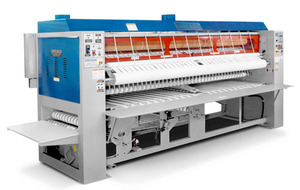
Flatwork ironers are machines used to automatically press sheets, pillow cases, table linens, etc. Their primary purpose is to remove wrinkles and they also dry the linens at the same time. If you want to achieve a 3-star rating or higher for your hotel or lodging facility, you must iron the sheets.

Heating options
Available heating options include steam, gas, oil and electric.
- Steam ironers are the most popular and they require a steam boiler be installed in your facility to operate.
- Oil ironers operate with hot oil pumped in a loop between the roller and the oil heater.
- Gas ironers are popular with small and medium-sized laundries.
- Electric ironers are very expensive to operate and should only be considered with no other utilities are available.
Production rates
An ironer’s production is described as how many sheets per hour it can process. This is a factor of how many feet per minute of material the ironer can churn through. The number and size of heated rollers in an ironer determines how many pieces per hour you can process. Each wet sheet will take heat away from rollers with evaporative cooling. The faster you try to run the sheets, the more heat you need out of your roller. If you have a small-diameter roller, you will not be able to keep it hot enough to process the linens very rapidly. If you have a large-diameter or multiple large-diameter rollers, you can increase the production speed dramatically. If you have thousands of sheets to process each day, you will need a high-speed ironer with large rollers. Some models can process upwards of 800 sheets per hour. For a high production application, an ironer with 2, 48-inch rollers can press and dry 800 or more sheets per hour at a speed of 135 feet per minute. An ironer with only one, 24-inch roller can only process about 280 sheets per hour.
Effectiveness
The primary factors in determining an ironer’s effectiveness are contact time and chest/roller temperatures. It takes 2,000 Btu’s to evaporate one pound of water. You must transfer enough energy to the linen to completely evaporate all the water in them so the extraction speed of the washer will play a key roll in just how much energy is required to dry each piece. More water in the linens means they must remain in contact with the roller longer or the roller must be hotter or both to get them dry. This relates directly to the number of pieces you can process each hour.
A good rule of thumb to consider when sizing your ironer is that 50% of your daily linen production will be terry linens and the other 50% will be flat goods like sheets, tablecloths and napkins that will need to go through your ironer.
Feature selection
Ironers are available with a variety of custom features and attachments that will provide an ironer that is perfect for your operations. Some smaller laundries have ironers that are used for ironing sheets and at other times, for ironing towels. You never know if what is being fed into the ironer will be homogenous from one end to the other. Sometimes, towels being fed into one end of the ironer are thicker than towels being fed into the other end. High-quality sheets with high thread counts are markedly thicker on one or both of the ends due to the ‘cuffs’. Since all the product moves at the same speed (same roller), sometimes it is advantageous to have an ironer that you can adjust the temperature of different segments of the roller. You can make it hotter on the ends when you need more drying power on the ends.
Feeders
Ironers can be fitted with feeders and/or folders to truly accelerate your production. These attachments are truly marvels of modern manufacturing and are absolutely necessary for any larger laundry facility. A feeder allows a single worker to feed 400 or more sheets per hour into the machine. The employee reaches into a pile of clean, wet linen, grabs a sheet, locates a corner of the sheet and sticks it into a small clip on the front of the machine. Then they locate the next nearest corner of the sheet and clip it into another clip and hit a button. The feeder instantly draws the wet, clumped sheet into the machine and almost magically it is able to completely spread out the sheet and feed it perfectly into the ironer in an instant. This hyper-accelerates the production flow at the ironer. More sophisticated feeders will allow up to 2 workers to simply ‘throw’ a sheet at the machine and it does the rest – eliminating the need to clip anything. These highly advanced feeders are necessary to produce 800 to 1,200 or more sheets per hour in a big ironer. These machines are truly fascinating to watch and operate.
Folders
A folder is exactly that, a folder. This equally advanced piece of equipment can take sheets coming from an ironer and almost instantly fold them into a small block of predetermined size. As a sheet comes off of the heated rollers, an air stream draws the long end of it into a slot and pulls it off the end of the roller. Another air stream pulls the trailing end back and when the sheet is midway over another slot in a perpendicular direction, another stream of air pulls the sheet down folding it in half. It does this several times in rapid succession until the sheet is perfectly folded in a block. A folder can also have a stacker attachment that will neatly stack a specified number of sheets before sending them on their way down a conveyor to a wrapping or banding machine and then on to a scale and computer tracker and invoice/packing slip printer.
